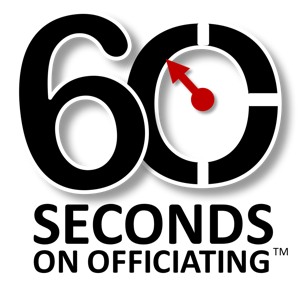Get A Leg Up On Kicking
The question before the committee – that being you and your partners on the officiating crew – is whether the official was correct in granting the timeout to Team A when A-1 gained possession of the ball by securing it between their legs.
Or was the Team B head coach correct, the official was premature in awarding the timeout because a player is not considered to be in possession of the ball when they have it between their legs, and the official should have waited until A-1 got their hands firmly on the ball?
Or should the official have ruled A-1’s actions to be a violation and awarded Team B the ball as a result of the infraction for kicking the ball?
The correct answer is….
A-1’s action of leg-locking the ball was illegal and the official should have ruled a kicking violation.
Now if the U-1 official with the dissenting opinion had weighed in quickly and confidently that A-1’s action was a violation, the ruling official could have processed and evaluated the information, and presumably have changed their call and awarded Team B the ball for a designated spot thrown in closest to violation.
But if this conversation took place after the timeout had begun, the remedy would be a little stickier as you would have to inform Team A of the mistake in awarding them possession and the subsequent timeout, and then resume play with Team B taking possession.
Of course we know there is a third option to ‘leave things as they are,’ as uncertainty swirls around this scenario. Unless someone in the officiating crew steps forward quickly and confidently to rule this a violation, the best course of action is to stay with the timeout ruling, and pull out the rule book when you all get into the locker room.
The violation of kicking the ball is defined as the INTENTIONAL act of striking the ball with any part of the leg or foot.
So the act of a player intentionally securing the ball with their feet, legs or thighs would therefore be a violation. This would also negate Team B’s head coach’s complaint that the timeout was given too early by A-1 controlling the ball with their legs. As soon as A-1 intentionally contacted the ball with any part of their leg, it became a violation.
You can branch out from here to create any type of scenario, common occurrence or otherwise, involving the ball contacting a player’s foot or leg, and if your eyes and instincts tell you the contact is the result of an INTENTIONAL act by the player, then you should rule this a kicking violation.
This coin has two-sides and that requires officials to determine …
if the ball contacting a player’s foot or leg was in fact, ACCIDENTAL.
The ball meeting up with a player’s foot or leg was either a deliberate act or a random encounter; and that is what they pay you the big bucks to decide! 🙂
And don’t be fooled by the distance the ball may travel after striking a player’s foot or leg…If A-1 attempts to make a pinpoint bounce pass to A-2 and the pass hits B-1’s stationary foot or leg and caroms away, this is accidental contact and you should let play continue uninterrupted.
This 60-Second clarification, along with your keen vision and sound judgment, will help you rule flawlessly on that age-old story of when ball meets leg!
NFHS Rule reference: 4-29; 9-4

Great Article. I really enjoy Sixty Seconds of Officiating.
Enjoy your day,
Andre’ Levisy
President
Western Valley Basketball Officials Association
Roanoke, Virginia
Kick ball !!!!
Guys,
One of your better articles regarding a somewhat infrequent ruling… however, a ruling that requires rule knowledge and intent, a dual combination equally as infrequent
RT
Disagree totally no where in the rule does it say this a kicked ball.
When an offensive player A1 has the ball and begins to pass to teammate A2-while the ball is the air following the release- a defensive player B1 lifts their leg up in a motion to stop the pass and the ball hits the inner thigh of B1 just as their foot makes contact back onto the floor and deflecting the ball away. Is this considered a “kick ball ” violation?